Metal Whiskers: Failure Modes & Mitigation Strategies - NEPP - NASA
Metal Whiskers: Failure Modes & Mitigation Strategies - NEPP - NASA
Metal Whiskers: Failure Modes & Mitigation Strategies - NEPP - NASA
You also want an ePaper? Increase the reach of your titles
YUMPU automatically turns print PDFs into web optimized ePapers that Google loves.
<strong>Metal</strong> <strong>Whiskers</strong>:<br />
<strong>Failure</strong> <strong>Modes</strong> and<br />
<strong>Mitigation</strong> <strong>Strategies</strong><br />
Jay Brusse / Perot Systems<br />
Dr. Henning Leidecker / <strong>NASA</strong> Goddard<br />
Lyudmyla Panashchenko / Univ. of MD-CALCE Graduate Student<br />
December 5, 2007 Microelectronics Reliability &<br />
Qualification Workshop<br />
http://nepp.nasa.gov/whisker<br />
1
• A Brief History of <strong>Metal</strong> <strong>Whiskers</strong><br />
Outline<br />
• System <strong>Failure</strong> <strong>Modes</strong> Caused by<br />
<strong>Metal</strong> <strong>Whiskers</strong><br />
• A Few <strong>Mitigation</strong> <strong>Strategies</strong> to<br />
Reduce Harm From <strong>Metal</strong><br />
<strong>Whiskers</strong><br />
December 5, 2007 <strong>Metal</strong> <strong>Whiskers</strong>:<br />
<strong>Failure</strong> <strong>Modes</strong> and <strong>Mitigation</strong> <strong>Strategies</strong><br />
Zinc <strong>Whiskers</strong> on<br />
Hot Dip Galvanized Steel Pipe<br />
• NO WHISKER GROWTH THEORY TO BE DISCUSSED!!!<br />
Cover Photo:<br />
Tin whiskers on Tin-Plated<br />
Beryllium Copper PCB Card Rails<br />
2
What are Tin or Zinc or Cadmium <strong>Whiskers</strong>?<br />
• Hair-like structures made of a single grain, or only<br />
a few grains, that sometimes erupt from a metal.<br />
Coatings of Tin, Zinc and Cadmium are especially<br />
able to develop whiskers; but, whiskers have been<br />
seen on Gold, Silver, Lead, and other metals too<br />
• Growth occurs over time by accretion of metal ions<br />
at the base NOT the tip<br />
• LENGTH: Log-normally distributed<br />
Rarely up to 10 mm or more<br />
(Typically ~1mm or less)<br />
• THICKNESS: Range 0.006 to >10 um<br />
(Typical ~ 1 um)<br />
• Fundamental theories for growth mechanism<br />
DO NOT enable prediction of the time-dependence<br />
of whisker density, whisker lengths or thicknesses<br />
– To be useful a theory should identify what we<br />
must control to make confident predictions<br />
– Such a theory has remained elusive<br />
December 5, 2007 <strong>Metal</strong> <strong>Whiskers</strong>:<br />
<strong>Failure</strong> <strong>Modes</strong> and <strong>Mitigation</strong> <strong>Strategies</strong><br />
Tin <strong>Whiskers</strong> on Tin-Plated<br />
Ceramic Chip Capacitor<br />
3
• 1946:<br />
H. Cobb (Aircraft Radio Corp.)<br />
publishes earliest “known” account of<br />
CADMIUM whiskers inducing<br />
electrical shorting between plates of<br />
air capacitors used in military<br />
equipment. These events occurred<br />
during World War II (~1942 – 1943)<br />
• 1952:<br />
Since Cadmium coatings resulted in<br />
shorting, Tin and Zinc were used<br />
instead. But then K.G. Compton, A.<br />
Mendizza, and S.M. Arnold (Bell Labs)<br />
reported shorting caused by whiskers<br />
from these coatings too!<br />
<strong>Metal</strong> <strong>Whiskers</strong><br />
“The Early Years”<br />
December 5, 2007 <strong>Metal</strong> <strong>Whiskers</strong>:<br />
<strong>Failure</strong> <strong>Modes</strong> and <strong>Mitigation</strong> <strong>Strategies</strong><br />
Tin <strong>Whiskers</strong> on 1960’s Era<br />
Variable Air Capacitor<br />
4
Whisker Resistant <strong>Metal</strong> Coatings<br />
“The Quest”<br />
• 1950s and 60’s:<br />
Bell Labs worked through the periodic table,<br />
to determine whether addition of some<br />
element to a Tin coating would “quench”<br />
whiskering<br />
– Adding 0.5 - 1% (by weight) of lead (Pb) works<br />
– Some additives seem to enhance whiskering<br />
• Since 1990s:<br />
Most MIL specs require adding Pb to any tin<br />
coatings used around electronics.<br />
– Concentration is usually named as 2% to 3%<br />
Pb by weight for “margin”<br />
• What additives quench zinc and<br />
cadmium whiskers?<br />
– We don’t know, but certainly NOT chromate<br />
conversion finishes!<br />
Zinc <strong>Whiskers</strong> Growing from<br />
Zinc-Plated Yellow Chromate<br />
Steel Bus Rail<br />
December 5, 2007 <strong>Metal</strong> <strong>Whiskers</strong>:<br />
<strong>Failure</strong> <strong>Modes</strong> and <strong>Mitigation</strong> <strong>Strategies</strong><br />
5
Relays<br />
Tin <strong>Whiskers</strong><br />
Transformer Can<br />
Tin <strong>Whiskers</strong><br />
<strong>Metal</strong> <strong>Whiskers</strong> on Components<br />
Computer Room Flooring<br />
Zinc <strong>Whiskers</strong><br />
Connector<br />
Cadmium <strong>Whiskers</strong><br />
December 5, 2007 <strong>Metal</strong> <strong>Whiskers</strong>:<br />
<strong>Failure</strong> <strong>Modes</strong> and <strong>Mitigation</strong> <strong>Strategies</strong><br />
D-Sub Connector<br />
Tin <strong>Whiskers</strong><br />
Lugs<br />
Tin <strong>Whiskers</strong><br />
6
1960’s Vintage<br />
Transistor<br />
Guess What’s Lurking Inside?<br />
Transistor Package is Tin-Plated Inside.<br />
Many Vintage Radio Malfunctions Have Been<br />
Attributed to <strong>Whiskers</strong> Shunting Case to Terminals<br />
http://www.vintage-radio.net/forum/showthread.php?t=5058<br />
December 5, 2007 <strong>Metal</strong> <strong>Whiskers</strong>:<br />
<strong>Failure</strong> <strong>Modes</strong> and <strong>Mitigation</strong> <strong>Strategies</strong><br />
7
2006- <strong>NASA</strong> GSFC Presented<br />
A Partial History of Documented<br />
<strong>Metal</strong> Whisker Problems<br />
http://nepp.nasa.gov/whisker/reference/tech_papers/2006-Leidecker-Tin-Whisker-<strong>Failure</strong>s.pdf<br />
Year** Application Industry <strong>Failure</strong> Cause <strong>Whiskers</strong> on?<br />
1946 Military Military Cadmium <strong>Whiskers</strong> Capacitor plates<br />
1948 Telecom Equipment<br />
Year** Application<br />
Telecom<br />
1954 Telecom Equipment Telecom<br />
Cadmium<br />
Industry<br />
<strong>Whiskers</strong><br />
Zinc <strong>Whiskers</strong><br />
Channel<br />
<strong>Failure</strong><br />
Filters<br />
Cause<br />
Channel Filters<br />
<strong>Whiskers</strong> on?<br />
1959 Telecom Equipment<br />
1959 Telecom Equipment<br />
1959 Telecom Equipment<br />
1990 Apnea Telecom Monitors Tin Medical <strong>Whiskers</strong> (RECALL) -Copper Zinc <strong>Whiskers</strong> Oxide Rectifier Rotary Switch<br />
1990 Duane Arnold Nuclear Year** Power Application -Potentiometer<br />
<strong>Metal</strong> Industry <strong>Whiskers</strong> <strong>Failure</strong> LPRM Cause Detectors <strong>Whiskers</strong> on?<br />
Power Station<br />
-Protector Mounting (Mechanical)<br />
1992 Missile Program “C” 2000Military GALAXY VII (Side 2) -Terminal Tin Space <strong>Whiskers</strong> (Complete Strip Loss) Tin Xsistor <strong>Whiskers</strong> Package +Standoff Relays<br />
1993 Govt. Electronics Govt. Systems -Relay Tin <strong>Whiskers</strong> Mechanical Elements Transistor, Diode, Lug<br />
2000 Missile Program “D” Military Tin <strong>Whiskers</strong> Terminals<br />
1995 Telecom Equipment<br />
2000Cadmium Telecom<br />
Power Mgmt <strong>Whiskers</strong> Modules Relay Zinc<br />
Industrial Armature <strong>Whiskers</strong>Return Spring Tin<br />
Framework<br />
<strong>Whiskers</strong> Connectors<br />
1996 Computer TelecomRouters 2000Cadmium Computers SOLIDARIDAD or Zinc I (Side 2) -Chassis/Structural Zinc Space <strong>Whiskers</strong> (Complete Loss) Members Tin Chassis <strong>Whiskers</strong> Relays<br />
1996 MIL Aerospace <strong>Whiskers</strong> MIL Aerospace -Variable Tin <strong>Whiskers</strong> Air Capacitor Relays<br />
1959 Telecom Equipment<br />
1986 F15 Radar<br />
1998 Aerospace Telecom Electronics 2001Tin, Space GALAXY Zinc or IIIR Cadmium (Side 1) <strong>Metal</strong> Tin Space Enclosures/Cans<br />
<strong>Whiskers</strong><br />
1998 Computer Hardware 2001<br />
<strong>Whiskers</strong> Computers Hi-Rel Zinc Hi-Rel <strong>Whiskers</strong><br />
1998 DBS-1 (Side 1) 2001Space Nuclear Power Plant Tin Power <strong>Whiskers</strong><br />
2001 Space Ground Test Eqpt Ground Support<br />
1998 Dresden History nuclear from 1959 Power to 1985 Power Not Detailed Herein <strong>Metal</strong> <strong>Whiskers</strong><br />
2002 DirecTV 3 (Side 1) Space<br />
Station<br />
2002 Electric Power Plant Power<br />
1998 GALAXY MilitaryIV (Side 2) 2002Tin Space GPS <strong>Whiskers</strong> Receiver (Complete Loss) Hybrid Tin Aeronautical <strong>Whiskers</strong> Package Lid<br />
Tin Hybrid <strong>Whiskers</strong> Package Lid Relays<br />
Tin Chassis <strong>Whiskers</strong> Ceramic Chip Caps<br />
Tin Relays <strong>Whiskers</strong> Relays<br />
Zinc <strong>Whiskers</strong> Bus Rail<br />
LPRM Detectors<br />
Tin <strong>Whiskers</strong> Relays<br />
Tin <strong>Whiskers</strong> Microcircuit Leads<br />
Tin Relays <strong>Whiskers</strong> RF Enclosure<br />
1986 Heart Pacemakers Medical (RECALL) 2002Tin MIL <strong>Whiskers</strong> Aerospace Crystal MIL Aerospace Can<br />
Tin <strong>Whiskers</strong> Mounting Hardware (nuts)<br />
1986 Phoenix Missile 1998 GALAXY MilitaryVII (Side 1) 2002Tin Space Military <strong>Whiskers</strong> Aircraft Electronics Tin Military <strong>Whiskers</strong> Enclosure<br />
1987 Dresden nuclear Power 1998 Military PowerAerospace 2002<br />
<strong>Metal</strong> Military Nuclear<br />
<strong>Whiskers</strong> Aerospace Power Plant<br />
LPRM Tin Power <strong>Whiskers</strong> Detectors<br />
Station<br />
1998 PAS-4 (Side 1) 2003Space Commercial Electronics Tin Telecom <strong>Whiskers</strong><br />
2003 Missile Program “E” Military<br />
1987 MIL/Aerospace PWB 1999 Eng MIL/Aerospace Computer Center Tin Architectural <strong>Whiskers</strong> PWB Zinc traces <strong>Whiskers</strong><br />
2003 Missile Program “F” Military<br />
1988 Missile Program “A” 1999 SOLIDARIDAD Military I (Side 1) Tin Space <strong>Whiskers</strong> Relays Tin <strong>Whiskers</strong><br />
2003 Telecom Equipment Telecom<br />
1999 South Texas Nuclear Plant 2004Power Military Tin Military <strong>Whiskers</strong><br />
Tin Relays <strong>Whiskers</strong> Relays<br />
Tin Plastic <strong>Whiskers</strong> Film Capacitor Potentiometer<br />
Tin Relays <strong>Whiskers</strong> RF Enclosure<br />
Tin <strong>Whiskers</strong> Connectors<br />
Floor Tiles<br />
Tin <strong>Whiskers</strong> Relays<br />
Relays<br />
Tin <strong>Whiskers</strong> Ckt Breaker<br />
Tin Relays <strong>Whiskers</strong> Waveguide<br />
2005 Communications Radio (1960s vintage) Tin <strong>Whiskers</strong> Transitor TO Package<br />
199X Telecom Equipment 2005Telecom Millstone Nuclear Power<br />
Plant<br />
Zinc Power <strong>Whiskers</strong> Tin PSU <strong>Whiskers</strong> Housing Diode (Axial Leads)<br />
2005 OPTUS B1 Space Tin <strong>Whiskers</strong> Relays<br />
2005 Telecom Equipment Telecom Tin <strong>Whiskers</strong> RF Enclosure<br />
2006 GALAXY IIIR (Side 2) Space Tin <strong>Whiskers</strong> Relays<br />
These are ~10% of the Problems We Know About<br />
December 5, 2007 <strong>Metal</strong> <strong>Whiskers</strong>:<br />
<strong>Failure</strong> <strong>Modes</strong> and <strong>Mitigation</strong> <strong>Strategies</strong><br />
8
“There is a name for those who suppose<br />
that doing the same thing will produce<br />
different results. That name is ‘Idiot’.”<br />
December 5, 2007 <strong>Metal</strong> <strong>Whiskers</strong>:<br />
<strong>Failure</strong> <strong>Modes</strong> and <strong>Mitigation</strong> <strong>Strategies</strong><br />
- Albert Einstein<br />
9
Basic Whisker <strong>Failure</strong> <strong>Modes</strong><br />
Electrical Short Circuits<br />
• Continuous short if I whisker < I melt<br />
• Intermittent short if I whisker > I melt<br />
Debris/Contamination<br />
• Interfere with Sensitive Optics or MEMS<br />
• Produce Shorts in Areas REMOTE From Whisker Origins<br />
(Zinc <strong>Whiskers</strong> on raised flooring are a PRIME Example)<br />
METAL VAPOR ARC<br />
• If I whisker >> I melt Whisker Can Vaporize into a <strong>Metal</strong> Gas<br />
• If EMF is sufficiently high, then the metal gas can be<br />
ionized into a conductive PLASMA of <strong>Metal</strong> Ions<br />
• Plasma Can Form an Arc Capable of Carrying<br />
HUNDREDS OF AMPS! Depends on arc gap length, voltage,<br />
current, pressure, etc.<br />
December 5, 2007 <strong>Metal</strong> <strong>Whiskers</strong>:<br />
<strong>Failure</strong> <strong>Modes</strong> and <strong>Mitigation</strong> <strong>Strategies</strong><br />
10
<strong>Metal</strong> Whisker Melting Current -- Pt. 1<br />
⎛ T<br />
⎜<br />
⎝ T<br />
− Where Lz ~ 2.45*10 -8 (V/K) 2 is the Lorenz number, T melt = melting temperature,<br />
T 0 = ambient temperature, R 0 = whisker resistance at ambient<br />
Tin<br />
I<br />
Material<br />
Cadmium<br />
Zinc<br />
melt,<br />
vac<br />
If V whisker> V melt<br />
Then the Whisker will Fuse Open<br />
But there is MORE to this story<br />
December 5, 2007 <strong>Metal</strong> <strong>Whiskers</strong>:<br />
<strong>Failure</strong> <strong>Modes</strong> and <strong>Mitigation</strong> <strong>Strategies</strong><br />
=<br />
⎡<br />
⎢<br />
⎣<br />
T melt<br />
505.1K<br />
594.2K<br />
692.7K<br />
2<br />
L<br />
R<br />
0<br />
Z<br />
T<br />
0<br />
⎤<br />
⎥<br />
⎦<br />
cos<br />
I melt, vac<br />
−1<br />
87.5 mV / R 0<br />
97.1 mV / R 0<br />
104.4 mV / R 0<br />
0<br />
melt<br />
⎞<br />
⎟<br />
⎠<br />
V melt = R 0 * I melt, vac<br />
88 mV<br />
97 mV<br />
104 mV<br />
See Backup Slides for Derivation<br />
11
<strong>Metal</strong> Whisker Melting Current -- Pt. 2<br />
• <strong>Metal</strong> whiskers are also coated with electrically insulating films<br />
– Tin oxides, Zinc oxides, moisture films, et al<br />
• Direct MECHANICAL contact by the whisker to another conductor<br />
does NOT guarantee ELECTRICAL contact<br />
– For Electrical Contact, the potential difference must exceed<br />
“dielectric breakdown” of the insulating films<br />
– For tin and zinc whiskers, independent groups have confirmed the<br />
oxide film breakdown ranges from ~ 0.2V to ~ 45V<br />
Electrical Current Flow through<br />
this Tin Whisker did not occur<br />
until V applied ~ 3 V at which point<br />
the Whisker promptly melted<br />
December 5, 2007 <strong>Metal</strong> <strong>Whiskers</strong>:<br />
<strong>Failure</strong> <strong>Modes</strong> and <strong>Mitigation</strong> <strong>Strategies</strong><br />
See Backup Slides for a<br />
Suggested Circuit for Measuring<br />
<strong>Metal</strong> Whisker Resistance<br />
12
Sustained <strong>Metal</strong> Vapor Arcing<br />
• Gaps shorter than a few tens of microns<br />
can support a sustained arc at potential<br />
differences of 12 to 14 volts, and currents<br />
of 0.1 to 0.3 amperes.<br />
– See “Electrical Contacts” by Paul G. Slade,<br />
part three<br />
• However, as the arc gap increases, the<br />
EMF needed to sustain the arc increases,<br />
as does the current.<br />
– GSFC testing of FM08 style fuses with<br />
metal filaments ~5 mm long finds ~ 75 volts<br />
at more than 30 amperes is needed to<br />
generate a sustained arc across this arc<br />
gap when P ~1 torr<br />
December 5, 2007 <strong>Metal</strong> <strong>Whiskers</strong>:<br />
<strong>Failure</strong> <strong>Modes</strong> and <strong>Mitigation</strong> <strong>Strategies</strong><br />
Tin <strong>Whiskers</strong> Growing on Armature<br />
Of Relay Produced <strong>Metal</strong> Vapor Arc<br />
G. Davy, "Relay <strong>Failure</strong> Caused by Tin <strong>Whiskers</strong>", Northrop Grumman, Technical Article, October 2002<br />
http://nepp.nasa.gov/whisker/reference/tech_papers/davy2002-relay-failure-caused-by-tin-whiskers.pdf<br />
13
How do People with “<strong>Whiskers</strong>” Cope?<br />
December 5, 2007 <strong>Metal</strong> <strong>Whiskers</strong>:<br />
<strong>Failure</strong> <strong>Modes</strong> and <strong>Mitigation</strong> <strong>Strategies</strong><br />
14
My Whisker “Stress Relaxation Theory”<br />
Man with “Facial <strong>Whiskers</strong>”<br />
Does YOGA!<br />
December 5, 2007 <strong>Metal</strong> <strong>Whiskers</strong>:<br />
<strong>Failure</strong> <strong>Modes</strong> and <strong>Mitigation</strong> <strong>Strategies</strong><br />
Men with “<strong>Metal</strong> <strong>Whiskers</strong>”<br />
Find Innovative Ways to Relieve Stress<br />
15
A Case for Whisker <strong>Mitigation</strong> <strong>Strategies</strong>?<br />
Tin <strong>Whiskers</strong> on Tin-Plated Axial Leaded Diodes<br />
• PWB and components were NOT Conformal Coated<br />
• Diode Leads were NOT Hot Solder Dipped<br />
December 5, 2007 <strong>Metal</strong> <strong>Whiskers</strong>:<br />
<strong>Failure</strong> <strong>Modes</strong> and <strong>Mitigation</strong> <strong>Strategies</strong><br />
Images Courtesy of T. Riccio (STPNOC)<br />
16
Three Whisker <strong>Mitigation</strong> <strong>Strategies</strong><br />
<strong>Mitigation</strong> – to make less severe or painful<br />
Merriam-Webster Dictionary<br />
• Avoid Use of Whisker Prone Surface Finishes<br />
– Perform independent materials composition analysis<br />
– “Trust, But VERIFY!” using X-ray Fluorescence (XRF), Energy<br />
Dispersive X-ray Spectroscopy (EDS), et al<br />
• Conformal Coat<br />
– Can slow whisker growth<br />
– Can block whiskers from electrically shunting distant conductors<br />
• Remove/Replace Tin Finishes When Practical<br />
– Hot Solder Dip using lead-tin (Pb-Sn) solders<br />
– “First Do No Harm” Principle<br />
December 5, 2007 <strong>Metal</strong> <strong>Whiskers</strong>:<br />
<strong>Failure</strong> <strong>Modes</strong> and <strong>Mitigation</strong> <strong>Strategies</strong><br />
Risk “<strong>Mitigation</strong>” ≠ Risk “Elimination”<br />
17
• Specimen:<br />
<strong>NASA</strong> Goddard Whisker <strong>Mitigation</strong> Study<br />
Conformal Coat (Uralane 5750* Polyurethane)<br />
~9 Years of Office Ambient Storage<br />
– 1” x 4”x 1/16” Brass 260<br />
– Tin-Plated 200 microinches<br />
– Intentional scratches created<br />
after plating<br />
• Conformal Coating:<br />
– Uralane 5750 on ½ of sample<br />
– Nominal Thickness = 2 mils<br />
• Storage Conditions:<br />
– Office Ambient ~ 9 years<br />
* Uralane TM 5750 now known as Aralane TM 5750<br />
NO<br />
Conformal<br />
Coat<br />
December 5, 2007 <strong>Metal</strong> <strong>Whiskers</strong>:<br />
<strong>Failure</strong> <strong>Modes</strong> and <strong>Mitigation</strong> <strong>Strategies</strong><br />
Uralane<br />
Coated<br />
18
<strong>NASA</strong> Goddard Whisker <strong>Mitigation</strong> Study<br />
Conformal Coat (Uralane 5750* Polyurethane)<br />
~9 Years of Office Ambient Storage<br />
• Coating Thickness Can Vary<br />
Depending on Process<br />
Parameters<br />
• <strong>NASA</strong> Test Coupons had a<br />
“transition” region ~2 mm wide<br />
where the conformal coating<br />
thickness was variable between<br />
0 and 2 mils<br />
• One must understand their own<br />
processes to ensure the coating<br />
thickness is sufficient<br />
everywhere you intend it to be!!<br />
* Uralane TM 5750 now known as Aralane TM 5750<br />
December 5, 2007 <strong>Metal</strong> <strong>Whiskers</strong>:<br />
<strong>Failure</strong> <strong>Modes</strong> and <strong>Mitigation</strong> <strong>Strategies</strong><br />
No Conformal Coat<br />
Coating Thickness<br />
From 0 to 2 mils<br />
2 mils of<br />
Conformal Coat<br />
<strong>NASA</strong> GSFC Conformal Coat<br />
Tin Whisker Test Coupon<br />
19
Control Areas – No Conformal Coat<br />
9-Years of Office Ambient Storage<br />
• Control Areas Grew <strong>Whiskers</strong> Abundantly<br />
– Avg: 55 ± 19.6 whiskers / mm 2<br />
– Range: 23 to 95 whiskers / mm 2<br />
December 5, 2007 <strong>Metal</strong> <strong>Whiskers</strong>:<br />
<strong>Failure</strong> <strong>Modes</strong> and <strong>Mitigation</strong> <strong>Strategies</strong><br />
No Conformal Coat<br />
20
Uralane 5750 – 2 Mils Thick<br />
9-Years of Office Ambient Storage<br />
• Conformal Coated Areas Grew <strong>Whiskers</strong> Too<br />
– To date ALL whiskers are contained beneath the coating that is 2 mils thick<br />
– With SEM we cannot see into the coating. Instead we see “domes” caused by<br />
whiskers that lift coating slightly<br />
– Avg: 3.4 ± 2.6 domes / mm 2<br />
– Range: 0 to 10.6 domes / mm 2<br />
December 5, 2007 <strong>Metal</strong> <strong>Whiskers</strong>:<br />
<strong>Failure</strong> <strong>Modes</strong> and <strong>Mitigation</strong> <strong>Strategies</strong><br />
We suspect we are only counting “thick”<br />
whiskers in this statistic because the “thin”<br />
ones mechanically buckle before they can lift<br />
the coating enough to produce visible “domes”<br />
Conformal Coat Area<br />
Debris on surface<br />
21
Whisker Puncture vs. Coating Thickness<br />
~2 mils of Uralane 5750<br />
<strong>Whiskers</strong> completely contained<br />
BENEATH the coating<br />
With nominal thickness of 2 mils<br />
December 5, 2007 <strong>Metal</strong> <strong>Whiskers</strong>:<br />
<strong>Failure</strong> <strong>Modes</strong> and <strong>Mitigation</strong> <strong>Strategies</strong><br />
Decreasing Coating Thickness<br />
<strong>Whiskers</strong> punch through<br />
in this region where<br />
Coating thickness < ~0.2 mils<br />
22
2 Mils Uralane =<br />
Very Effective<br />
<strong>Whiskers</strong> Completely<br />
Entrapped Under the<br />
Coating ���� Euler Buckling<br />
Uralane 5750 Conformal Coat -<br />
9-Years of Office Ambient Storage<br />
~0.5 Mils Uralane =<br />
Less Effective<br />
Whisker “Lifting” Coating<br />
into Shape of Circus Tent,<br />
But Not Yet Penetrating<br />
December 5, 2007 <strong>Metal</strong> <strong>Whiskers</strong>:<br />
<strong>Failure</strong> <strong>Modes</strong> and <strong>Mitigation</strong> <strong>Strategies</strong><br />
~0.1 Mils Uralane =<br />
Not Effective<br />
<strong>Whiskers</strong> Breaking<br />
Through<br />
“Thin” Coating<br />
23
FB<br />
Euler Buckling<br />
Axial Force Required to Buckle a <strong>Metal</strong> Whisker<br />
( ) ⎟ 2<br />
3<br />
4<br />
π<br />
EI ⎛ π ⋅ E ⎞⎛<br />
d ⎞<br />
= ≈ ⎜<br />
⎟<br />
⎜<br />
2<br />
2<br />
KL ⎝ 32 ⎠⎝<br />
L ⎠<br />
E = Young’s Modulus of whisker material,<br />
I = Area Moment of Inertia,<br />
(e.g. I = π d 4 / 64 for circular cross section)<br />
L = Length of whisker,<br />
K = Column Effective Length Factor<br />
K = 0.5 for whisker fixed at both ends<br />
K = 0.7 for fixed at one end, pinned at other<br />
December 5, 2007 <strong>Metal</strong> <strong>Whiskers</strong>:<br />
<strong>Failure</strong> <strong>Modes</strong> and <strong>Mitigation</strong> <strong>Strategies</strong><br />
Conductor<br />
Conformal Coat<br />
“Whisker”<br />
F B<br />
Whisker Growth Surface<br />
24
<strong>Whiskers</strong> Lift and Peel Conformal Coat<br />
Until Whisker Buckles OR Coating Fails<br />
(F peel vs. F Buckle)<br />
• As whisker first emerges it is short and stiff<br />
thus F B > F peel and whisker begins to lift the<br />
coating forming a “circus tent” with height<br />
L = length of whisker;<br />
• “Tent” joins the surface at a circle of<br />
circumference C ~ 2πQL,<br />
– Q describes the details of tent-like shape<br />
• To peel conformal coating up and away from<br />
the surface, one needs to apply a force (F peel)<br />
proportional to the circumference:<br />
– F peel = Φ * C = 2 pi Q Φ L<br />
Φ = peel strength of material which describes the<br />
adhesion of the coating to the tin, and the effect<br />
of the separation angle. It also depends on the<br />
rate at which the coating is peeled away.<br />
Additional Analysis Pending<br />
December 5, 2007 <strong>Metal</strong> <strong>Whiskers</strong>:<br />
<strong>Failure</strong> <strong>Modes</strong> and <strong>Mitigation</strong> <strong>Strategies</strong><br />
Whisker<br />
Under<br />
Coating<br />
Conformal Coat<br />
F B<br />
C<br />
F peel<br />
Whisker Growth Surface<br />
Uralane 5750 has better self-cohesion<br />
than adhesion to a tin surface<br />
L<br />
25
Will <strong>Whiskers</strong> Buckle Before<br />
Puncturing a Distant Coated Surface?<br />
• The displacement of the conformal coat due to a whisker pushing<br />
against the coating is:<br />
D<br />
( ) ⎟ 2<br />
3<br />
3<br />
⎛ 1 −ν<br />
⎞⎛<br />
F ⎛ ⎞ ⎛ ⎞⎛<br />
⎞<br />
B ⎞ π<br />
2 E W d<br />
= ⎜<br />
⎟<br />
⎟⎜<br />
⎟ ≈ ⎜<br />
⎟ 1 −ν<br />
⎜ ⎟ ⎜ 2<br />
⎝ E ⎠⎝<br />
d ⎠ ⎝ 32 ⎠ ⎝ E coat ⎠⎝<br />
L ⎠<br />
coat<br />
Where<br />
D = Displacement of conformal coat<br />
ν = Poisson’s ratio<br />
E coat = Young’s Modulus of coating<br />
E W = Young’s Modulus of Whisker<br />
d = “Diameter” of whisker<br />
L = Length of whisker<br />
F B = Euler Buckling Strength<br />
of the whisker<br />
December 5, 2007 <strong>Metal</strong> <strong>Whiskers</strong>:<br />
<strong>Failure</strong> <strong>Modes</strong> and <strong>Mitigation</strong> <strong>Strategies</strong><br />
F B<br />
Conductor<br />
26
Thank Goodness for Euler Buckling and<br />
Conformal Coat on this PWB!!!<br />
These Long <strong>Whiskers</strong> Experienced<br />
Euler Buckling Before Penetrating a<br />
Distant Conformal Coated Surface<br />
Tin Whisker “Buckling”<br />
Tin <strong>Whiskers</strong> Growing from<br />
Non-Conformal Coated Card Rail<br />
Photo Credit: M&P <strong>Failure</strong> Analysis Laboratory<br />
The Boeing Company Logistics Depot<br />
December 5, 2007 <strong>Metal</strong> <strong>Whiskers</strong>:<br />
<strong>Failure</strong> <strong>Modes</strong> and <strong>Mitigation</strong> <strong>Strategies</strong><br />
27
Effects of Conformal Coating -- 1<br />
• Numerous sorts of coatings have been tried:<br />
– Reports of success vary from “none” to “perfect”, sometimes for the same<br />
sort of coating.<br />
• <strong>NASA</strong> GSFC has used Uralane 5750, applied to pre-primed tin-plated<br />
surfaces to a thickness of 2 mils (=50 micrometers) +/- 10%:<br />
– After ~9 years of office ambient storage, these surfaces have whiskered<br />
abundantly, but the number of whiskers escaping through the 2 mil thick<br />
areas has been zero<br />
• Dr. Thomas Woodrow (Boeing) has studied Urethane (acrylic)<br />
coatings, a silicone coating, and Parylene C coating of varying<br />
thicknesses up to ~ 4 mils (= 100 micrometers):<br />
– Some whiskers have penetrated even the thickest coatings when exposed<br />
to 25°C / 97% R.H.<br />
December 5, 2007 <strong>Metal</strong> <strong>Whiskers</strong>:<br />
<strong>Failure</strong> <strong>Modes</strong> and <strong>Mitigation</strong> <strong>Strategies</strong><br />
28
Effects of Conformal Coating -- 2<br />
• Conclusion 1:<br />
– Uralane 5750, applied to at least 2 mils thickness, is a substantial<br />
improvement over an uncoated surface.<br />
• Conclusion 2:<br />
– It is possible to suppose the surface is protected when it is not<br />
– There can be “weak zones” of thin coating allowing vertical escape<br />
• Conclusion 3:<br />
– Even “poor” coatings can offer some protection against a whisker<br />
coming from a distant source and attempting to contact the protected<br />
surface --- long whiskers bend easily (Euler Buckling).<br />
– Conformal coat protects against a conductive bridge from detached<br />
whiskers lying across a pair of conductors<br />
December 5, 2007 <strong>Metal</strong> <strong>Whiskers</strong>:<br />
<strong>Failure</strong> <strong>Modes</strong> and <strong>Mitigation</strong> <strong>Strategies</strong><br />
29
Crystal with Tin-Plated Kovar Leads<br />
(with Nickel Underplate)<br />
• Leads were Hot Solder Dipped (Sn63Pb37)<br />
within 50 mils of Glass Seal BEFORE Mounting<br />
to enhance solderability<br />
• Dip was not 100% of leads due to concerns of<br />
inducing harm to glass seal<br />
Hot Solder Dip<br />
Benefits & Limitations<br />
Field <strong>Failure</strong> ONE Year After Assembly<br />
December 5, 2007 <strong>Metal</strong> <strong>Whiskers</strong>:<br />
<strong>Failure</strong> <strong>Modes</strong> and <strong>Mitigation</strong> <strong>Strategies</strong><br />
Tin <strong>Whiskers</strong> (~60 mils) Grew on<br />
NON-Dipped Region Shorting to Case<br />
Causing Crystal to Malfunction<br />
• No <strong>Whiskers</strong> on Hot Solder Dipped Surface<br />
• ABUNDANT whiskers on the Non-Dipped Surface<br />
30
Contact Information<br />
Jay Brusse<br />
Perot Systems at<br />
<strong>NASA</strong> Goddard Space Flight Center<br />
Jay.A.Brusse@nasa.gov<br />
Work Performed in Support of the<br />
<strong>NASA</strong> Electronic Parts and Packaging (<strong>NEPP</strong>) Program<br />
Acknowledgment to Dr. Michael Osterman<br />
University of MD – Center for Advanced Life Cycle Engineering (CALCE)<br />
<strong>NASA</strong> Tin and Other <strong>Metal</strong> Whisker WWW Site<br />
http://nepp.nasa.gov/whisker<br />
December 5, 2007 <strong>Metal</strong> <strong>Whiskers</strong>:<br />
<strong>Failure</strong> <strong>Modes</strong> and <strong>Mitigation</strong> <strong>Strategies</strong><br />
31
Backup Slides<br />
December 5, 2007 <strong>Metal</strong> <strong>Whiskers</strong>:<br />
<strong>Failure</strong> <strong>Modes</strong> and <strong>Mitigation</strong> <strong>Strategies</strong><br />
32
Tin <strong>Whiskers</strong> Forming “Circus Tents”<br />
in Thin Uralane 5750 Conformal Coat -<br />
9-Years of Office Ambient Storage<br />
Coating Thickness < 0.5 Mil<br />
December 5, 2007 <strong>Metal</strong> <strong>Whiskers</strong>:<br />
<strong>Failure</strong> <strong>Modes</strong> and <strong>Mitigation</strong> <strong>Strategies</strong><br />
33
Tin <strong>Whiskers</strong> Rupturing THIN Coating<br />
~0.1 to 0.2 Mils Uralane 5750 Conformal Coat<br />
9-Years of Office Ambient Storage<br />
December 5, 2007 <strong>Metal</strong> <strong>Whiskers</strong>:<br />
<strong>Failure</strong> <strong>Modes</strong> and <strong>Mitigation</strong> <strong>Strategies</strong><br />
34
A Few Recent Whisker Experiences<br />
• Tin <strong>Whiskers</strong>:<br />
– 2005: Connecticut Nuclear Power Plant shutdown due to Tin whiskers on diodes<br />
– 2006: Space Shuttle Transportation System discovers Tin whiskers on card rails: Some<br />
100 to 300 million whiskers were in OV-105's boxes<br />
– 2006: SWATCH reports 30% of crystals made using RoHS-compliant tin-copper solder<br />
sprouting Tin whiskers. 5% catastrophically shorted within months.<br />
• Zinc <strong>Whiskers</strong>:<br />
– 2005: Colorado State Government builds a new “disaster recovery center” after Zinc<br />
whiskers crippled its old data center<br />
– 2005: 75% of the computer equipment in a particular data center failed due to Zinc<br />
whiskers from raised floor tiles. Root cause identified in ~8 months later<br />
– 2006: Persistent NAVY weapon system failure confirmed caused by Zinc whiskers<br />
• Cadmium <strong>Whiskers</strong>:<br />
– 2006: Spaceflight program observes Cadmium whiskers on electrical switch<br />
– 2007: Test chamber feed-thru failure caused by Cadmium whiskers on connector shells<br />
December 5, 2007 <strong>Metal</strong> <strong>Whiskers</strong>:<br />
<strong>Failure</strong> <strong>Modes</strong> and <strong>Mitigation</strong> <strong>Strategies</strong><br />
35
Circuit to Measure Resistance of a <strong>Metal</strong> Whisker<br />
• Use of a simple “Ohmmeter” to measure the resistance of a metal<br />
whisker is NOT preferred<br />
– Ohmmeter may supply V out < V breakdown for the insulating films (oxides,<br />
moisture) that form on a metal whisker<br />
– Ohmmeter may supply V out > V melt causing the whisker to melt before<br />
resistance can be measured<br />
• Instead, a variable power supply and a ballast resistor should be used<br />
to overcome the above complications<br />
– Adjust V out > V breakdown of insulating films on whisker<br />
– When V out > V breakdown, R B quickly drops V whisker < V melt<br />
Circuit to measure Rw V −IRB<br />
RW<br />
=<br />
I<br />
Choose R B such that<br />
V whisker < 80% V melt<br />
December 5, 2007 <strong>Metal</strong> <strong>Whiskers</strong>:<br />
<strong>Failure</strong> <strong>Modes</strong> and <strong>Mitigation</strong> <strong>Strategies</strong><br />
+<br />
-<br />
V<br />
A<br />
R B ~ 100 kohms<br />
I<br />
R W<br />
36
• Basic Equipment:<br />
– Binocular Microscope<br />
Optical Inspection for<br />
<strong>Metal</strong> <strong>Whiskers</strong><br />
– Light Source: Flex Lighting PREFERRED over Ring Lamp<br />
• Freedom to tilt sample and/or lighting to illuminate whisker facets<br />
is VERY IMPORTANT<br />
Ring Lamp =<br />
“Not So Good”<br />
December 5, 2007 <strong>Metal</strong> <strong>Whiskers</strong>:<br />
<strong>Failure</strong> <strong>Modes</strong> and <strong>Mitigation</strong> <strong>Strategies</strong><br />
Flex Lamp =<br />
“Much Better”<br />
37
Evidence of “Absence of <strong>Whiskers</strong>”?<br />
(Optical Microscopy)<br />
0.5-mm long tin whisker<br />
Now You See Now It…<br />
Tin-Plated Lock Washer<br />
December 5, 2007 <strong>Metal</strong> <strong>Whiskers</strong>:<br />
<strong>Failure</strong> <strong>Modes</strong> and <strong>Mitigation</strong> <strong>Strategies</strong><br />
“Slight” Change in<br />
Angle of Lighting<br />
Makes this Whisker<br />
Invisible to Optical Inspection<br />
… Now You Don’t<br />
The absence of evidence is NOT evidence of absence<br />
38
Field Technicians and <strong>Failure</strong> Analysts Need<br />
To Be Acquainted with <strong>Metal</strong> <strong>Whiskers</strong>!!!<br />
<strong>NASA</strong> GSFC has published videos to aid in optical<br />
inspection for metal whiskers<br />
Now You See It<br />
Incident Angle Lighting<br />
http://nepp.nasa.gov/whisker/video<br />
Small Change in Angle of Lighting<br />
Makes Dramatic Difference<br />
During Optical Inspection<br />
December 5, 2007 <strong>Metal</strong> <strong>Whiskers</strong>:<br />
<strong>Failure</strong> <strong>Modes</strong> and <strong>Mitigation</strong> <strong>Strategies</strong><br />
Now You Don’t<br />
“Ring Light”<br />
39
Why Are Tin, Zinc, Cadmium Still Used?<br />
• Not all Tin (or Zinc or Cadmium) surfaces whisker!<br />
– Rough estimate: 3% to 30% do whisker.<br />
• Not all metal whiskers cause shorts<br />
– Environment (geometry and electrical potentials matter).<br />
– Rough estimate: 3% to 30% do short.<br />
• Not all whisker-induced shorts are traced to whiskers<br />
– They are very hard to see and failure analysis techniques often destroy evidence<br />
– Rough estimate: 0% to 10% are correctly traced.<br />
• Not all identified whisker adventures are reported<br />
– Rough estimate: 0% to 3% are reported, once identified<br />
• Hence, we expect between 0.00% and 0.03% of shorting problems caused<br />
by these coatings to be reported<br />
– While some 0.1% to 10% of these coatings are actually causing shorts.<br />
– With such a few public cases, many say “What, me worry?”<br />
• Whiskering is dramatically inhibited when 0.5% (or more) lead (Pb) is added<br />
to Tin coatings: the shorting rate then approaches zero<br />
– This has been the case for the Hi-Rel community<br />
– But Pb use is being restricted by international legislation, and so the shorting rate<br />
may jump to 10% from zero ==> SWATCH GROUP
"The Five Stages of <strong>Metal</strong> Whisker Grief"<br />
By Henning Leidecker<br />
Adapted from Elisabeth Kubler-Ross in her book "On Death and Dying",<br />
Macmillan Publishing Company, 1969<br />
Denial<br />
"<strong>Metal</strong> whiskers?!? We ain't got no stinkin' whiskers! I don't even think metal whiskers exist! I<br />
KNOW we don't have any!“<br />
Anger<br />
"You say we got whiskers, I rip your $%#@ lungs out! Who put them there --- I'll murderize him! I'll<br />
tear him into pieces so small, they'll fit under one of those *^&$#% whiskers!"<br />
Bargaining<br />
“We have metal whiskers? But they are so small. And you have only seen a few of them. How<br />
could a few small things possibly be a problem to our power supplies and equipment? These few<br />
whiskers should be easy to clean up."<br />
Depression<br />
"Dang. Doomed. Close the shop --- we are out of business. Of all the miserable bit joints in all the<br />
world, metal whiskers had to come into mine... I'm retiring from here... Going to open a 'Squat &<br />
Gobble' on the Keys. "<br />
Acceptance<br />
“<strong>Metal</strong> whiskers. How about that? Who knew? Well, clean what you can. Put in the particle filters,<br />
and schedule periodic checks of what the debris collectors find. Ensure that all the warrantees and<br />
service plans are up to date. On with life."<br />
December 5, 2007 <strong>Metal</strong> <strong>Whiskers</strong>:<br />
<strong>Failure</strong> <strong>Modes</strong> and <strong>Mitigation</strong> <strong>Strategies</strong><br />
41
u = c ⋅∆L<br />
⋅ A⋅T<br />
du<br />
dt<br />
T o<br />
Whisker<br />
C<br />
u = C ⋅T<br />
c =<br />
V<br />
⎛ C ⎞<br />
u = ⎜ ⎟⋅V<br />
⋅T<br />
= c ⋅V<br />
⋅T<br />
⎝ V ⎠<br />
∂T<br />
= c ⋅ ∆L<br />
⋅ A⋅<br />
∂t<br />
Derivation of Melting Current of a<br />
<strong>Metal</strong> Whisker in Vacuum<br />
∆ L<br />
L<br />
2a T o<br />
2<br />
⎡ ∂T<br />
⎤ ⎡ Lz<br />
⋅T<br />
⎛ ∂ T ⎞ ⎤ 2<br />
⎢c<br />
⋅∆L ⋅ A⋅<br />
− ⎢<br />
⋅∆L<br />
⋅ A⎥<br />
= J ⋅ ⋅∆L<br />
⋅ A<br />
t ⎥ ⎜<br />
⎣ x ⎟<br />
ρ<br />
2<br />
⎣ ∂ ⎦ ρ ⎝ ∂ ⎠ ⎦<br />
melt,<br />
vac<br />
December 5, 2007 <strong>Metal</strong> <strong>Whiskers</strong>:<br />
<strong>Failure</strong> <strong>Modes</strong> and <strong>Mitigation</strong> <strong>Strategies</strong><br />
I<br />
du<br />
dt<br />
⎡2<br />
= ⎢<br />
⎣<br />
+ Φ<br />
L<br />
R<br />
0<br />
Z<br />
=<br />
source = I ⋅ R<br />
2<br />
I = Je<br />
⋅<br />
T<br />
0<br />
source<br />
du/dt + Φ = source<br />
2<br />
⎡ ∂T<br />
⎤ ⎡ Lz ⋅T<br />
⎛ ∂ T ⎞⎤<br />
2<br />
⎢<br />
c ⋅<br />
⎥<br />
− ⎢<br />
⎥ = ⋅ ρ<br />
⎣ ρ ⎜<br />
⎟ J<br />
2<br />
⎣ ∂t<br />
⎦ ⎝ ∂x<br />
⎠⎦<br />
Assume both ends of<br />
Whisker are thermally<br />
grounded to T o<br />
Convection loss = 0 for vacuum<br />
Neglect radiation loss<br />
⎛ ∂J<br />
⎞<br />
Φ = ⎜ ⎟⋅<br />
∆L<br />
⋅ A<br />
⎝ ∂x<br />
⎠<br />
2<br />
∂T<br />
∂J<br />
∂ T<br />
J = −kT<br />
⋅<br />
= −kT<br />
⋅ 2<br />
∂x<br />
∂x<br />
∂x<br />
⎛ ∂ T ⎞<br />
Φ = −kT<br />
⋅ ⎜ ⋅∆L<br />
⋅ A<br />
x ⎟ 2<br />
⎝ ∂ ⎠<br />
2 2 2<br />
LZ<br />
⋅T<br />
source = ( Je<br />
⋅ A ) ⋅⎜<br />
⎟<br />
kT<br />
=<br />
⎝ A ⎠<br />
2<br />
LzT<br />
⎛ ∂ T ⎞<br />
Φ = − ⎜ ⋅ ∆L<br />
⋅ A<br />
x ⎟ 2<br />
ρ ⎝ ∂ ⎠<br />
ρ<br />
⎤<br />
⎥<br />
⎦<br />
A<br />
cos<br />
⎛ ρ ⋅ ∆L<br />
⎞<br />
−1<br />
⋅ ∆L<br />
R =<br />
A<br />
ρ<br />
2 ( J ⋅ A)<br />
⋅ ⋅ L<br />
source = e ρ ∆<br />
⎛ T<br />
⎜<br />
⎝ T<br />
0<br />
melt<br />
⎞<br />
⎟<br />
⎠<br />
42
An Example of “Melting” a Tin Whisker<br />
Before Contact<br />
1. Gold-Plated Test Probe has +3 Volts<br />
Relative to Tin Whisker<br />
After Contact<br />
December 5, 2007 <strong>Metal</strong> <strong>Whiskers</strong>:<br />
<strong>Failure</strong> <strong>Modes</strong> and <strong>Mitigation</strong> <strong>Strategies</strong><br />
1. Tip of whisker micro-welds to gold test probe<br />
2. Whisker melts mid-length<br />
Melted End<br />
of Whisker<br />
3. Small section of whisker root remains<br />
attached to substrate<br />
43


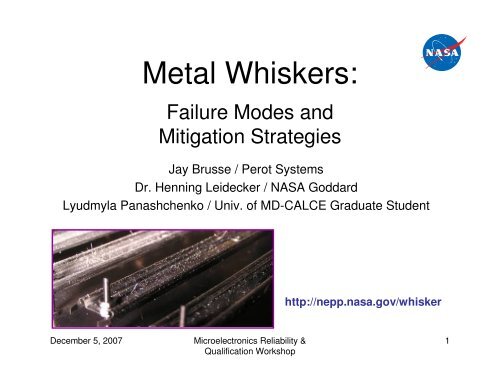
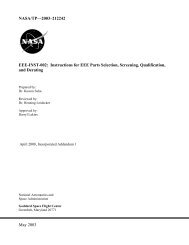

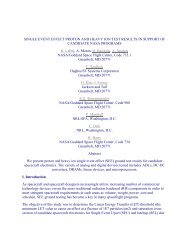
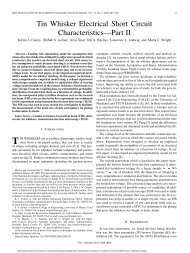
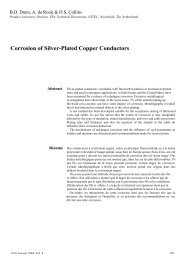
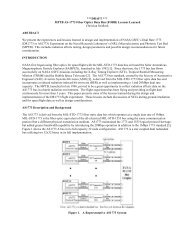

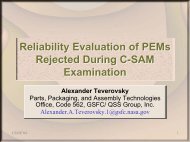
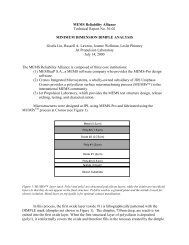
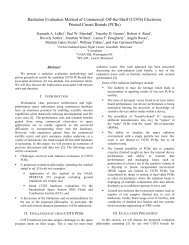

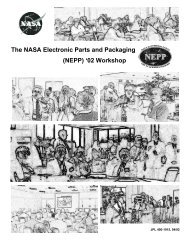

![mil-std-2223 [test methods for insulated electric wire] - NEPP](https://img.yumpu.com/4036001/1/190x249/mil-std-2223-test-methods-for-insulated-electric-wire-nepp.jpg?quality=85)